Scientists reveal important role for 'workhorse' of cell division
A new study shows how a crucial protein, which acts as trigger for cell division, helps release another key protein from the cell's "control center."
When cell division goes wrong, mistakes can be made in separating the chromosomes—packages of DNA which carry the cell's genetic information—between the two dividing cells. This can lead to cancerous growth.
The crucial cell cycle enzyme, Cyclin B1-Cdk1, is the trigger for cell division to begin. It is also referred to as the "workhorse" of cell division, responsible for coordinating other proteins involved in the complex process.
Cyclin B1 is found in increased amounts in some cancer types. The new study offers a greater understanding of its movements and interactions during cell division, and could in future lead to more specific ways to alter the activity of Cyclin B1-Cdk1 and other proteins it interacts with, in cancer treatment.
Cyclin B1 interacts with another key protein
Scientists at The Institute of Cancer Research, London, found that Cyclin B1 helps release a protein called MAD1—which plays a key role in cell division—from the cell's control center when it starts to divide.
When a cell divides, its chromosomes must be separated to form two identical 'daughter' cells from a single "parent" cell. This happens in a matter of minutes and the contents of the cell are completely reorganized in the process.
In the study, published in the Journal of Cell Biology and funded by Cancer Research UK, researchers analyzed the partners of Cyclin B1 and identified MAD1 as the protein with which it most strongly interacts.
They identified the precise area of the MAD1 protein which interacts with Cyclin B1, using gene editing to remove this part of the protein and showing that this prevented the two proteins from interacting.
This interaction allows MAD1 to perform its own crucial activities in the dividing process: MAD1 plays a key role in making sure each daughter cell received an equal and identical set of chromosomes.
Ensuring Cyclin B1 is in the right place at the right time
Using a gene editing tool known as CRISPR to alter its structure, researchers looked closely at the function of MAD1 and showed that the interaction between MAD1 and Cyclin B1 importantly ensures Cyclin B1 is in the right place at the right time during cell division.
Preventing Cyclin B1 interacting with MAD1 disrupted the process of cell division and led to mistakes being made in parceling out the chromosomes that were inherited by the two daughter cells.
MAD1 can function abnormally in some types of cancer, causing errors where cells divide unevenly, and one is left with more DNA than the other. A greater understanding of its functions in the process of cell division could lead to more precise ways to alter the activity of MAD1 in cancer treatment.
Scientists at the ICR worked for 15 years towards these findings which are fundamental to the wider understanding of cell biology and the intricate process of cell division. Many key processes involving Cyclin B1 were already known, but this study is the first to show the precise site on MAD1 which interacts with Cyclin B1, and the importance of this interaction in releasing MAD1 from the cells control center to enable subsequent events to take place.
A fundamental example of how cell division is regulated
Study leader Professor Jon Pines, Head of the Division of Cancer Biology at the ICR, said: "In this study, we show that Cyclin B1, a component of the workhorse of cell division, plays an important role in helping another crucial regulator, MAD1, to be released from the cell's control center. This is a fundamental example of how cell division is regulated in space and time. Our findings help us to understand the inter-dependent roles of these proteins, both of which can function abnormally in cancer cells. Greater knowledge of the way in which a cell's machinery is reorganized during the division process could lead us to new ways to tackle cancer."
More information: Mark Jackman et al. Cyclin B1-Cdk1 facilitates MAD1 release from the nuclear pore to ensure a robust spindle checkpoint, Journal of Cell Biology (2020). DOI: 10.1083/jcb.201907082
Journal information: Journal of Cell Biology
Provided by Institute of Cancer Research



















